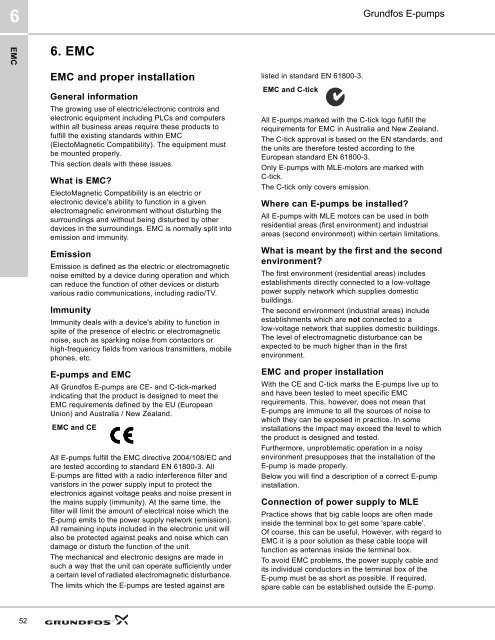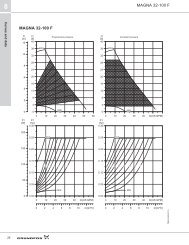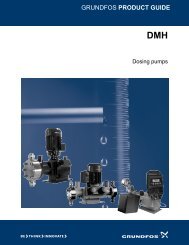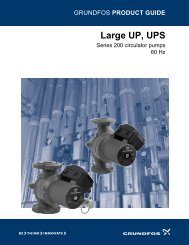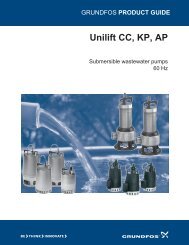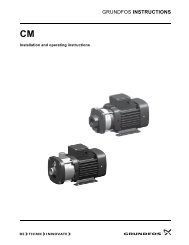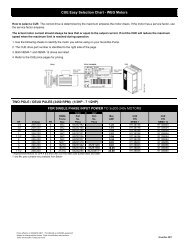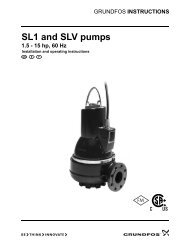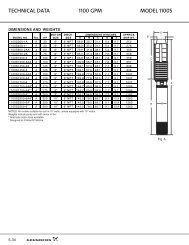You also want an ePaper? Increase the reach of your titles
YUMPU automatically turns print PDFs into web optimized ePapers that Google loves.
6<br />
<strong>Grundfos</strong> E-<strong>pumps</strong><br />
EMC<br />
6. EMC<br />
EMC and proper installation<br />
General information<br />
The growing use of electric/electronic controls and<br />
electronic equipment including PLCs and computers<br />
within all business areas require these products to<br />
fulfill the existing standards within EMC<br />
(ElectoMagnetic Compatibility). The equipment must<br />
be mounted properly.<br />
This section deals with these issues.<br />
What is EMC?<br />
ElectoMagnetic Compatibility is an electric or<br />
electronic device's ability to function in a given<br />
electromagnetic environment without disturbing the<br />
surroundings and without being disturbed by other<br />
devices in the surroundings. EMC is normally split into<br />
emission and immunity.<br />
Emission<br />
Emission is defined as the electric or electromagnetic<br />
noise emitted by a device during operation and which<br />
can reduce the function of other devices or disturb<br />
various radio communications, including radio/TV.<br />
Immunity<br />
Immunity deals with a device's ability to function in<br />
spite of the presence of electric or electromagnetic<br />
noise, such as sparking noise from contactors or<br />
high-frequency fields from various transmitters, mobile<br />
phones, etc.<br />
E-<strong>pumps</strong> and EMC<br />
All <strong>Grundfos</strong> E-<strong>pumps</strong> are CE- and C-tick-marked<br />
indicating that the product is designed to meet the<br />
EMC requirements defined by the EU (European<br />
Union) and Australia / New Zealand.<br />
EMC and CE<br />
All E-<strong>pumps</strong> fulfill the EMC directive 2004/108/EC and<br />
are tested according to standard EN 61800-3. All<br />
E-<strong>pumps</strong> are fitted with a radio interference filter and<br />
varistors in the power supply input to protect the<br />
electronics against voltage peaks and noise present in<br />
the mains supply (immunity). At the same time, the<br />
filter will limit the amount of electrical noise which the<br />
E-pump emits to the power supply network (emission).<br />
All remaining inputs included in the electronic unit will<br />
also be protected against peaks and noise which can<br />
damage or disturb the function of the unit.<br />
The mechanical and electronic designs are made in<br />
such a way that the unit can operate sufficiently under<br />
a certain level of radiated electromagnetic disturbance.<br />
The limits which the E-<strong>pumps</strong> are tested against are<br />
listed in standard EN 61800-3.<br />
EMC and C-tick<br />
All E-<strong>pumps</strong> marked with the C-tick logo fulfill the<br />
requirements for EMC in Australia and New Zealand.<br />
The C-tick approval is based on the EN standards, and<br />
the units are therefore tested according to the<br />
European standard EN 61800-3.<br />
Only E-<strong>pumps</strong> with MLE-motors are marked with<br />
C-tick.<br />
The C-tick only covers emission.<br />
Where can E-<strong>pumps</strong> be installed?<br />
All E-<strong>pumps</strong> with MLE motors can be used in both<br />
residential areas (first environment) and industrial<br />
areas (second environment) within certain limitations.<br />
What is meant by the first and the second<br />
environment?<br />
The first environment (residential areas) includes<br />
establishments directly connected to a low-voltage<br />
power supply network which supplies domestic<br />
buildings.<br />
The second environment (industrial areas) include<br />
establishments which are not connected to a<br />
low-voltage network that supplies domestic buildings.<br />
The level of electromagnetic disturbance can be<br />
expected to be much higher than in the first<br />
environment.<br />
EMC and proper installation<br />
With the CE and C-tick marks the E-<strong>pumps</strong> live up to<br />
and have been tested to meet specific EMC<br />
requirements. This, however, does not mean that<br />
E-<strong>pumps</strong> are immune to all the sources of noise to<br />
which they can be exposed in practice. In some<br />
installations the impact may exceed the level to which<br />
the product is designed and tested.<br />
Furthermore, unproblematic operation in a noisy<br />
environment presupposes that the installation of the<br />
E-pump is made properly.<br />
Below you will find a description of a correct E-pump<br />
installation.<br />
Connection of power supply to MLE<br />
Practice shows that big cable loops are often made<br />
inside the terminal box to get some 'spare cable'.<br />
Of course, this can be useful, However, with regard to<br />
EMC it is a poor solution as these cable loops will<br />
function as antennas inside the terminal box.<br />
To avoid EMC problems, the power supply cable and<br />
its individual conductors in the terminal box of the<br />
E-pump must be as short as possible. If required,<br />
spare cable can be established outside the E-pump.<br />
52


